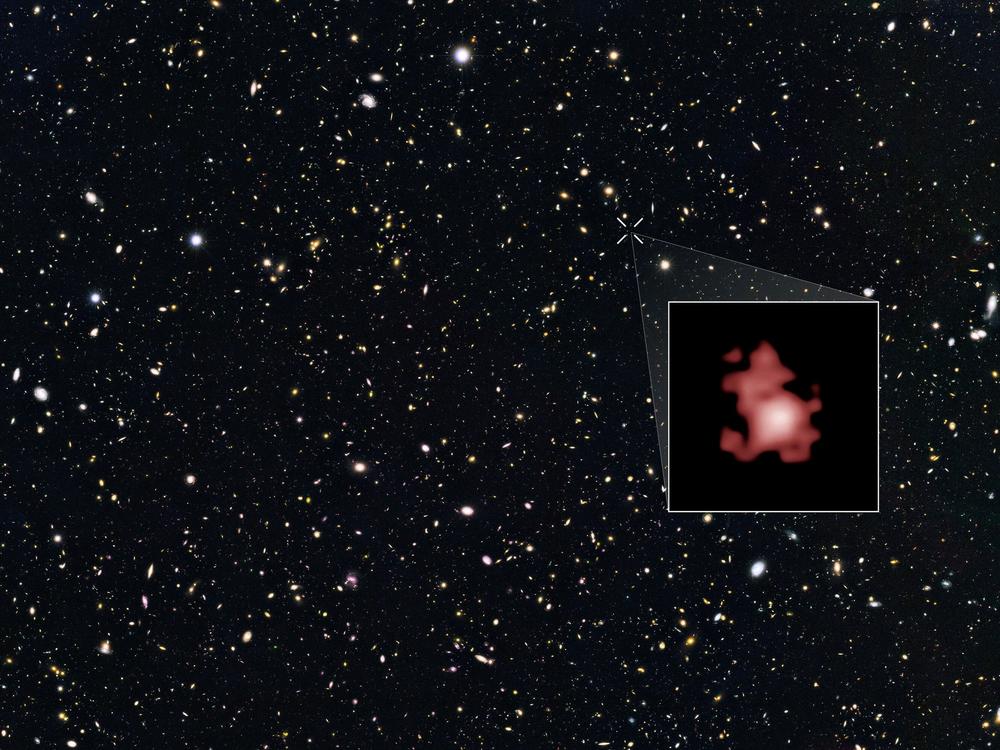Section Branding
Header Content
James Webb Telescope detects earliest known black hole — it's really big for its age
Primary Content
When the Hubble Space Telescope first spotted the galaxy GN-z11 in 2016, it was the most distant galaxy scientists had ever identified. It was ancient, formed 13.4 billion years ago — a mere 400 million years after the Big Bang.
But while GN-z11's record has since been broken, the galaxy remains something of a puzzle. For such an old and compact galaxy, it was oddly luminous. To be that bright, "it would have required a large number of stars packed in such a small volume," says Roberto Maiolino, an astrophysicist at the University of Cambridge. But, given how young the universe was, it would have been hard to make all those young, bright stars in that relatively short period of time.
Now, in a paper entitled "A small and vigorous black hole in the early Universe," published in Nature, Maiolino and his colleagues have an alternative explanation for all that light: a supermassive black hole about 1.6 million times the mass of our Sun. The black hole itself doesn't emit any light — but all the material screaming toward it, Maiolino proposes, may well be hot and bright enough to produce the galaxy's intense radiance.
He says this is the earliest black hole ever detected, and its very existence calls into question where certain black holes come from and how they feed and grow.
A new telescope reveals a remarkable rainbow
For the last twenty years, Maiolino has helped develop the James Webb Space Telescope that launched on Christmas Day 2021. In particular, he's part of the team that designed and built one of its key instruments called the near-infrared spectrometer.
"The instrument [is] responsible for splitting the light of galaxies and stars [into] their colors," he says. "So it's essentially the rainbow of the galaxy."
When Maiolino and his colleagues directed the powerful new telescope and their instrument at the galaxy known as GN-z11, the detail that came streaming back was stunning.
"It was super exciting," he recalls. "But at the beginning, we didn't really realize what it was telling us. The spectrum was quite puzzling."
So the team deepened their analysis and collected more data. And they speculated that the bright ultraviolet glow emanating from the distant galaxy was probably coming from huge amounts of gas swirling around and pouring into a black hole. The friction of all that gas being pulled inwards would have heated and lit it up, likely explaining why the galaxy is so luminous.
That's how Maiolino and his team figured out what they were dealing with — a supermassive black hole parked in the center of the galaxy.
"At that point," he says, "the excitement had doubled and got even more interesting, of course."
A special black hole
This wasn't just any black hole. First — assuming that the black hole started out small — it could be devouring matter at a ferocious rate. And it would have needed to do so to reach its massive size.
"This black hole is essentially eating the [equivalent of] an entire Sun every five years," says Maiolino. "It's actually much higher than we thought could be feasible for these black holes." Hence the word "vigorous" in the paper's title.
Second, the black hole is 1.6 million times the mass of our Sun, and it was in place just 400 million years after the dawn of the universe.
"It is essentially not possible to grow such a massive black hole so fast so early in the universe," Maiolino says. "Essentially, there is not enough time according to classical theories. So one has to invoke alternative scenarios."
Here's scenario one — rather than starting out small, perhaps supermassive black holes in the early universe were simply born big due to the collapse of vast clouds of primordial gas.
Scenario two is that maybe early stars collapsed to form a sea of smaller black holes, which could have then merged or swallowed matter way faster than we thought, causing the resulting black hole to grow quickly.
Or perhaps it's some combination of both.
In addition, it's possible that this black hole is harming the growth of the galaxy GN-z11. That's because black holes radiate energy as they feed. At such a high rate of feasting, this energy could sweep away the gas of the host galaxy. And since stars are made from gas, it could quench star formation, slowly strangling the galaxy. Not to mention that without gas, the black hole wouldn't have anything to feed on and it too would die.
"These authors have made a persuasive case that there is a black hole," says Priyava Natarajan, an astrophysicist at Yale University who wasn't involved in the study, "despite the fact that it has not been detected" using X-rays, which are the gold standard to test for the presence of a black hole.
Natarajan was part of a team that recently used both the new James Webb Space Telescope and X-ray data from the Chandra X-Ray Observatory to find a supermassive black hole in a different part of the universe that existed 470 million years after the Big Bang — so a touch more recent than this latest discovery.
A discovery which, Natarajan says is, "revealing the diversity of black holes and their host galaxies. We see a diversity today, and it looks like this diversity starts quite early on."
Copyright 2024 NPR. To see more, visit https://www.npr.org.

